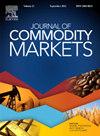全球货币供应与能源和非能源商品价格:MS-TV-VAR方法
IF 4.5
4区 经济学
Q1 BUSINESS, FINANCE
引用次数: 0
摘要
本文表明,全球货币供应对能源的影响比对非能源商品价格的影响不成比例地高。能源商品价格的全球货币供应增加主要导致需求拉动型通胀,而对于非能源商品价格,全球货币供应增加导致需求拉动型和成本拉动型通胀,因为能源是非能源商品的关键投入。为了量化这种影响,我们使用具有时变转移概率的马尔可夫切换模型。该模型考虑了全球货币供应缓慢、适度和快速增长的时期。我们发现,能源对全球货币供应冲击的反应几乎是非能源大宗商品价格的两倍。我们还发现,在不同制度下,能源和非能源商品的反应也不尽相同。本文章由计算机程序翻译,如有差异,请以英文原文为准。
Global money supply and energy and non-energy commodity prices: A MS-TV-VAR approach
This paper shows that the impact of the global money supply is disproportionally higher for energy than for non-energy commodities prices. An increase in the global money supply for energy commodity prices results mainly in demand-pull inflation, while, for non-energy commodity prices, an increase in global money supply leads to demand-pull and cost-push inflation, as energy is a key input for non-energy commodities. To quantify this effect, we use a Markov switching model with time-varying transition probabilities. This model considers periods of slow, moderate, and fast global money supply growth. We find that the response to global money supply shocks is almost double for energy than for non-energy commodity prices. We also find heterogeneous responses for energy and non-energy commodities under different regimes.
求助全文
通过发布文献求助,成功后即可免费获取论文全文。
去求助
来源期刊

Journal of Commodity Markets
Multiple-
CiteScore
5.70
自引率
2.40%
发文量
53
期刊介绍:
The purpose of the journal is also to stimulate international dialog among academics, industry participants, traders, investors, and policymakers with mutual interests in commodity markets. The mandate for the journal is to present ongoing work within commodity economics and finance. Topics can be related to financialization of commodity markets; pricing, hedging, and risk analysis of commodity derivatives; risk premia in commodity markets; real option analysis for commodity project investment and production; portfolio allocation including commodities; forecasting in commodity markets; corporate finance for commodity-exposed corporations; econometric/statistical analysis of commodity markets; organization of commodity markets; regulation of commodity markets; local and global commodity trading; and commodity supply chains. Commodity markets in this context are energy markets (including renewables), metal markets, mineral markets, agricultural markets, livestock and fish markets, markets for weather derivatives, emission markets, shipping markets, water, and related markets. This interdisciplinary and trans-disciplinary journal will cover all commodity markets and is thus relevant for a broad audience. Commodity markets are not only of academic interest but also highly relevant for many practitioners, including asset managers, industrial managers, investment bankers, risk managers, and also policymakers in governments, central banks, and supranational institutions.
 求助内容:
求助内容: 应助结果提醒方式:
应助结果提醒方式:


